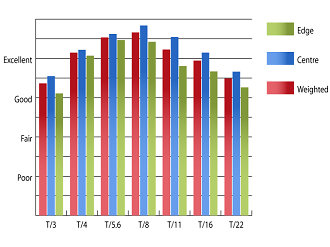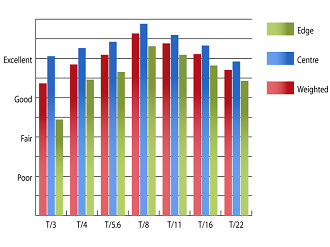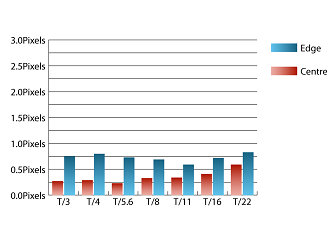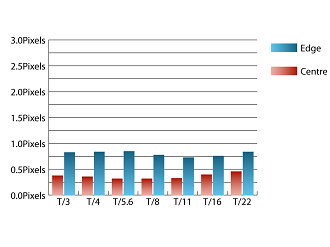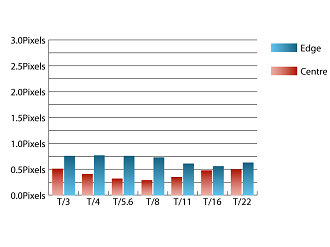Tokina Cinema AT-X 16-28mm T/3 Lens Review
Tokina Cinema AT-X 16-28mm T/3 Performance
Shooting wide open at 16mm, sharpness in the centre of the image is already very good, with the quality towards the edges not being far behind. Stopping the lens down improves sharpness across the frame until T/8, where performance is outstanding across the frame.
At 20mm, sharpness in the centre is excellent at T/3, but the quality towards the edges drops to fairly good levels. Just as at 16mm, peak performance across the frame is achieved at T/8, where sharpness is again, outstanding across the frame.
Finally at 28mm, the sharpness in the centre of the image remains very good at T/3, and just as at 20mm, the quality towards the edges remains fairly good. Stopping see sto improve performance in the centre of the frame faster than towards the edges of the frame. Sharpness reaches outstanding levels in the centre between T/4 and T/8, peaks with very good levels of clarity towards the edges of the frame at T/16.
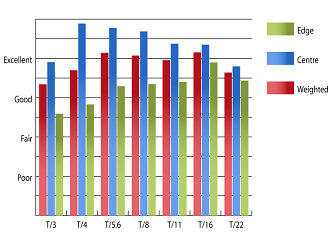
MTF@28mm
How to read our charts
The blue column represents readings from the centre of the picture frame at the various apertures and the green is from the edges. Averaging them out gives the red weighted column.The scale on the left side is an indication of actual image resolution. The taller the column, the better the lens performance. Simple.
For this review, the lens was tested on a Canon EOS 5D Mark III using Imatest.
Levels of chromatic aberrations towards the edges are well controlled throughout the zoom range, with fringing never exceeding a pixel width towards the edges of the frame. This amount of fringing should be difficult to spot, even in scenes with high contrast towards the edges of the frame.
Apochromatic lenses have special lens elements (aspheric, extra-low dispersion etc) to minimize the problem, hence they usually cost more.
For this review, the lens was tested on a Canon EOS 5D Mark III using Imatest.
For a lens with such a wide field of view and a fast maximum aperture of f/2.8, falloff of illumination towards the corners is very well controlled. At 16mm the corners are 1.65stops darker than the image centre and at 28mm this is reduced to 0.72stops. Visually uniform illumination is achieved at f/5.6 throughout the zoom range.
Distortion is extremely well corrected throughout the zoom range. At 16mm 2.5% barrel distortion is present and at 28mm, this drops to 0.34%. This amount of distortion will pose few issues, being very difficult to spot in video footage.
Very few issues with flare were encountered during testing, and when it did appear, it looked quite pretty. Although the flare created can be visually appealing, it is not always desirable. Contrast levels hold up well, even when shooting into the light.
Value For Money
Comparing this lens to the SLR version is a little like comparing apples to oranges, as they are designed for completely different cameras and purposes. Even so, as you can mount this lens on Canon EF bodies, some may be tempted to draw comparison. The casual video-taker, who owns an SLR that is largely un-adapted for video work, will probably do better with the standard Tokina 16-28mm lens, which costs around £700.
Those looking at this lens as a viable alternative to other 4K ready cinema lenses, will find the £4000 price tag quite reasonable when compared to other lenses, especially those available for the Arri PL mount.
Add your message
Please login here or if you've not registered, you can register here. Registering is safe, quick and free.
photodo Stats
428 MTF tests
74 in-depth photodo reviews
100+ users join each day
Help the lens community by reviewing or rating a lens today via our lens search
Latest Lens Reviews
- Chinon 28mm f/2.8 Vintage Lens Review
- Canon EF 70-200mm f/4L IS II USM Lens Review
- Samyang AF 85mm f/1.4 EF Review
- Sigma 70mm f/2.8 DG Macro Art Review
- Samyang AF 24mm f/2.8 FE Review
- Meike 50mm f/1.7 Review
- Tamron 70-210mm f/4 Di VC USD Review
- Lensbaby Burnside 35mm f/2.8 Review
- Asahi Super Takumar 50mm f/1.4 Review
- Asahi Super-Multi-Coated Takumar 135mm f/3.5 Review
